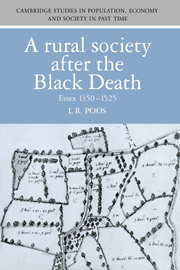Book contents
- Frontmatter
- Contents
- List of figures
- List of tables
- Preface
- Abbreviations
- Part I Reflections on a transitional era
- Part II ‘Country-dwellers, common folk and craftsmen’
- Part III ‘The total sum of all persons’
- 5 Population aggregates over time
- 6 Components of demographic equilibrium
- Part IV ‘While it is so forward between us’
- Part V ‘She came that day seeking service’
- Part VI ‘Beware of such holy men’
- Part VII Synthesis
- Bibliography
- Index
- Cambridge Studies in Population, Economy and Society in Past Time 18
6 - Components of demographic equilibrium
Published online by Cambridge University Press: 14 September 2009
- Frontmatter
- Contents
- List of figures
- List of tables
- Preface
- Abbreviations
- Part I Reflections on a transitional era
- Part II ‘Country-dwellers, common folk and craftsmen’
- Part III ‘The total sum of all persons’
- 5 Population aggregates over time
- 6 Components of demographic equilibrium
- Part IV ‘While it is so forward between us’
- Part V ‘She came that day seeking service’
- Part VI ‘Beware of such holy men’
- Part VII Synthesis
- Bibliography
- Index
- Cambridge Studies in Population, Economy and Society in Past Time 18
Summary
The rural population of Essex achieved a remarkable period of equilibrium at low absolute levels for most of the time from the end of the fourteenth to the early sixteenth century. Emphasis here is upon ‘equilibrium’, because population adapted itself to its biological, economic and social-structural environment in such a way that mortality and fertility balanced each other out over an extended period of time. Such is clear from the Essex tithing data. But to move beyond mere aggregates in order to consider the components of demographic equilibrium makes much more serious demands upon available empirical evidence. At present it seems unlikely that there will ever be anything like precise measures of broadly based mortality or fertility levels from medieval English sources, or indeed absolute consensus regarding relationships between the two variables. And yet, as the case of Essex demonstrates, that does not necessarily mean that tentative inferences are wholly impossible.
The relative importance of mortality and fertility in defining the course of later-medieval population raises issues that extend far beyond the period's demography narrowly defined. To decipher this equilibrium makes it necessary to understand the social-structural and economic underpinnings of household formation as a process over time. Ultimately, these questions raise the more basic issue of how far later-medieval England's demographic system differed from or resembled the country's population regime in the post-medieval centuries.
A traditional, and still probably the majority, view of the late-medieval English population would place mortality at centre-stage. In this view, an already unfavourable economic climate resulting from population growth extending into the early 1300s was transformed by the arrival of plague in the country during the Black Death of 1348–9.
- Type
- Chapter
- Information
- A Rural Society after the Black DeathEssex 1350–1525, pp. 111 - 130Publisher: Cambridge University PressPrint publication year: 1991



